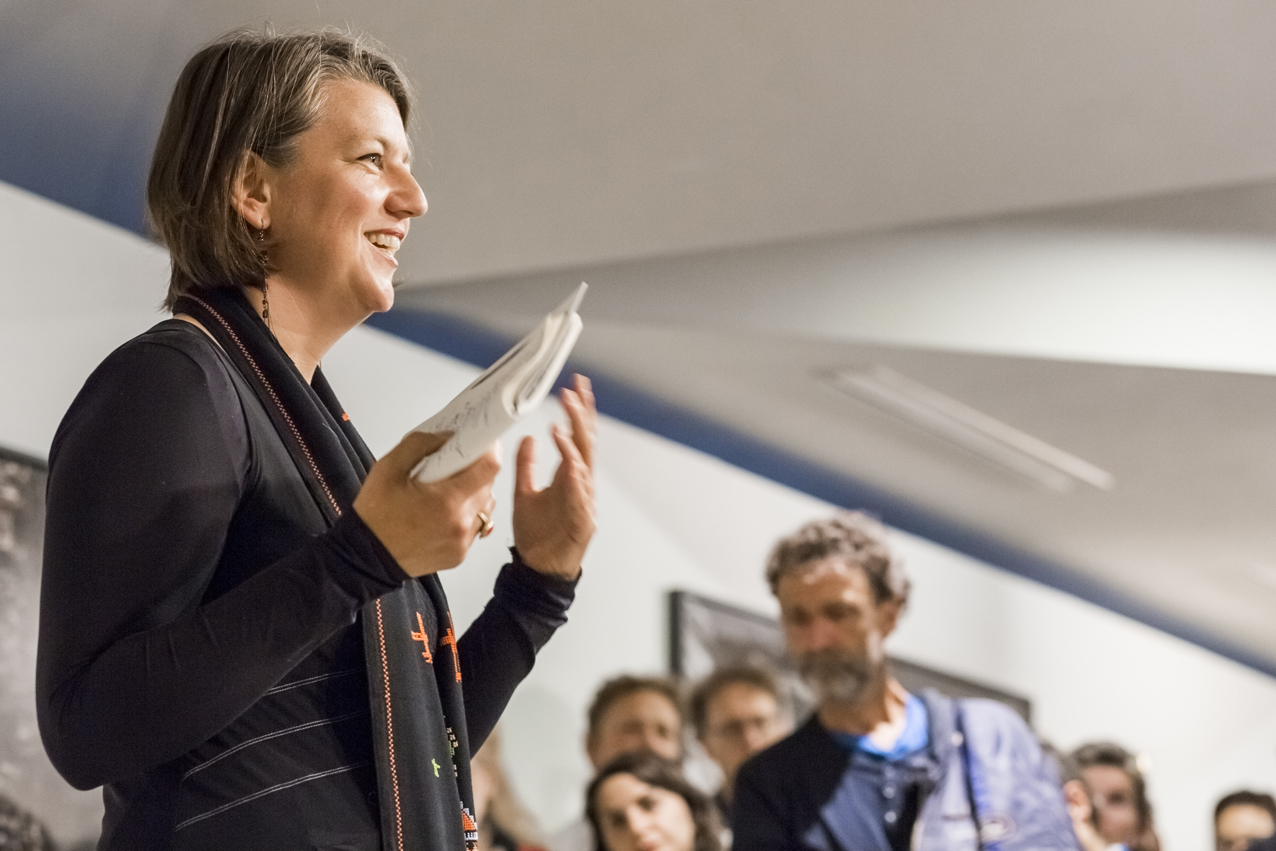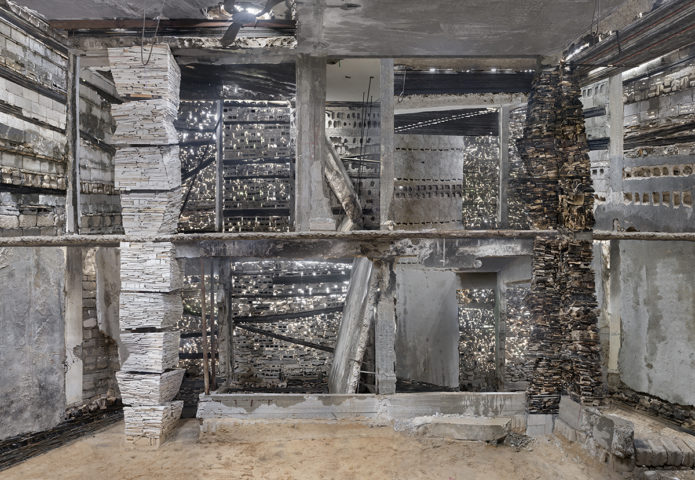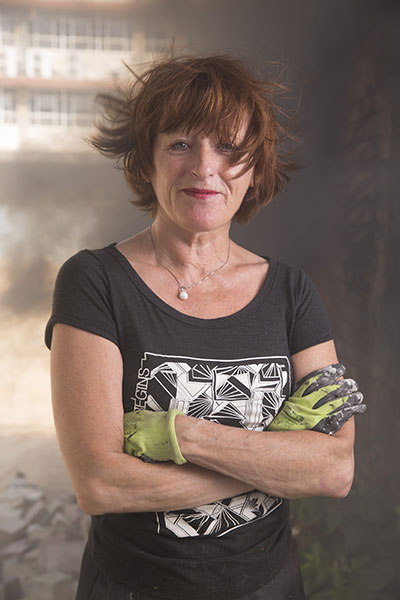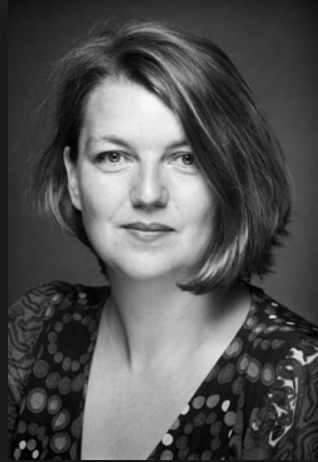 Meta Knol at the opening of HOME, 14 July 2017. Photo: Marlise Steeman
Meta Knol at the opening of HOME, 14 July 2017. Photo: Marlise Steeman Opening speech HOME, by curator Meta Knol
EXHIBITION OPENING HOME, FRAMER FRAMED
Amsterdam, July 14, 2017
In 2015, the Italian writer and philosopher Claudio Magris published the novel ‘Non luogo a procedere’, of which the Dutch translation, entitled ‘Het museum van de oorlog’ (the museum of war) was published last year. The book is about an extraordinary man, living in the Italian city of Trieste – a collector. He is collecting stuff: weapons, grenades, tanks and even submarines; all kinds of paraphernalia that represent violence. He does this because he has set himself the task of establishing a gigantic museum which is entirely dedicated to war. In doing so, he means to collect all evil, in order to secure that in the surrounding world only peace will remain.
Of course the man is a lunatic, a maniac, an alienated extravagant. But don’t forget – he is acting out of love. The author, Claudio Magris, once said about this figure in an interview (and I am merely paraphrasing him here): “Indeed, his manic collecting is a flight into order. Creating order, classifying, is a shield that protects you from the decay in life, from the idea that it can all be over in one split second. A collection will not disappoint you, it will not cheat on you. You can contain it. It is an ordered storage of dead objects, which somehow shield you from life itself.’
So here is this man, madly collecting the madness of disaster. How does this relate to us, today? I think Magris’ book can be understood as a reflection on the museum as a mental space, as an alternative for the harsh, physical, outside world we call reality. A museum takes objects from its original context and turns them into something meaningful. Marjan Teeuwen, in a way, did the same. She turned the physical of the Gaza Strip reality into an imaginary, mental space. She took the leftovers of a house destroyed by war, and turned them into something meaningful. She turned chaos into order. She changed an unsafe place into a shelter for the mind. And as such, what she did, was an act of love.
In today’s globalized world, we all know bad shit happens, in other places and countries. But somehow we fail to connect to it, because it never really affects us. Some time ago, I read this column of Caroline de Gruyter in the Dutch newspaper NRC Handelsblad. She wrote: ‘A world in which more and more walls are being erected which ‘lock in’ one group and ‘lock out’ the other, needs openness and freedom. Culture can contribute to that openness and freedom.’ Angela Merkel has named this principle too. She called it ‘Weltoffenheit’ – openness to the world. What Marjan Teeuwen did, is opening up the Gaza Strip cage to the world. By means of imagination.
I am convinced that this also explains why Framer Framed and the project Destroyed House Gaza fit well together. Framed Framed is a young cultural organization that steps out of the strongly discoursed ‘comfort zone’ of the Dutch contemporary art scene. They show ‘Weltoffenheit’; openness to the world. They do so, based on the acknowledgement that in current times we all somehow share the same space, which is no longer restricted by our own local roots, families, villages, cities or even national boundaries. In the mediatized world of today, people know – or rather, let’s say they can be aware of – what lies behind their own horizon. Framer Framed opens up this perspective on a globalized scale, within the framework of art, culture and society. In doing so, they operate from within a highly critical and self-reflective attitude. And as such they are delivering major contributions to understanding – in bits and pieces – the huge paradigm-shift that is taking place in our contemporary world.
You will say: yeah, well, ok, it’s nice to talk about ‘Weltoffenheit’ and about shared spaces. But what does it actually mean in the context of this exhibition? DO we share a space with Gaza? ARE we not locked out of this distressed reality by our own, comfortable, Dutch, ‘business-as-usual’, daily lives? CAN we occasionally realize what it means if we open the newspaper, if we read the news, during our morning coffees?
Speaking for myself, I can only tell you this. I have been fascinated by the work of Marjan Teeuwen since my visit, in 2008, to the very first Destroyed House that she realized in Den Bosch. Following her work and development ever since, eventually made me commission her to establish a Destroyed House in Leiden, in 2015. For four months she worked in her own brave, characteristic spirit on changing a series of four neighbouring houses right next to Museum De Lakenhal and turning them into a monumental art installation (the houses were later going to be demolished to pave the way for the museum expansion, which is fully in process now). By carefully re-ordering the physical remains and tangible memories of these four houses, Marjan created an extraordinary, huge, sculptural-architectonical installation. During the process, occasionally the two of us would sit down for a tea or a cup of soup, and during one of those talks Marjan told me she was determined to do her next project in the Gaza Strip. To her, Gaza symbolized the place where forces of destruction and construction were colliding in the most extreme way, as an inevitable consequence of the continuous return of war.
I knew, when I heard this, that I wanted to go too. The least I could do was to step out of my own comfort zone and try to actually experience – feel – what life could, would, maybe, somehow, be like in a place such as the Gaza Strip. I would like to see for myself what Marjans work would do in this context, and how her art would relate to the circumstances of the Palestinian people. So I went to Gaza in December of last year to visit Marjan and to give a lecture to the local public, in and about Destroyed House Gaza. Of course, I know this was an extraordinary situation. I am aware of the complete inability to experience what living in a war zone means, because obviously I was no more than a temporary guest, travelling in and out of Gaza as a privileged passenger. There was no way that I could really understand it. And it is also this not-knowing which, in a strange way, still leads to my inability to find the right words to describe the fundamental depth of this experience.
But here we are. Marjan Teeuwen did it. Completely! She travelled to Gaza several times, stayed there for three months and realized Destroyed House Gaza. She connected to the local people and together they created this little community of support and interaction that helped build the project. Thus, an extraordinary art work was created out of a house that had been destroyed by a bombing in 2014, during the last Gaza War.
For a short while, Destroyed House Gaza served as a space for reflection, a memorial of sorts, where local visitors could temporarily gain some piece of mind. The men, women and children who visited the house recognized the act of creating a new order from the debris of their own lives – as an act to contain the loss, caused by war. However, it was the unexpected beauty of this new, artistic place that turned it into a mental space in which they could also reflect on their lives and all that had happened.
Some of those people will get a voice in this exhibition, through the contributions by Ezz al Zanoon and Rawan Mahady, two young people, a photographer and a journalist, from Gaza – who actually created a shared space. Through the internet, they are sending us their videoblogs and also through the internet, a series of public Skype sessions between Amsterdam and Gaza will take place in order to exchange information, visions and experiences.
Like the collection of Claudio Magris, in which the reality of war was turned into a museum, this project called ‘HOME’ creates a space at Framer Framed in which war is, somehow, transferred from Gaza to Amsterdam. Thus, disaster is transcended into art, in order to be experienced by you.
To understand this transfer, one needs a certain openness of mind. If we are lucky, this will encourage empathy. And empathy, so is my firm belief, is the only real weapon in the battle against war and exclusion.
Palestine / Curatorial Text /
Exhibitions

Exhibition: HOME
With work by Marjan Teeuwen, Ezz Al Zanoon and Rawan Mahady, curated by Meta Knol
Network

Marjan Teeuwen
Kunstenaar

